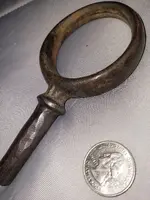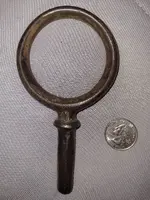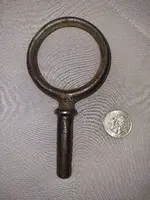Is this just a reins guide or something else? Cast iron, couple makers marks, no rope wear. How would it mount securely with the taperd stem? Is it even that old?
You are using an out of date browser. It may not display this or other websites correctly.
You should upgrade or use an alternative browser.
You should upgrade or use an alternative browser.
✅ SOLVED Detecting at an 1850's stage stop
- Thread starter Matten138
- Start date
Rein guide or an oar lock.
Thinking more on the oar lock thought as some rein guides had a threaded stem.
Though if the site is totally away from water, a rein guide would be the choice.
Nice recovery BTW.
Thinking more on the oar lock thought as some rein guides had a threaded stem.
Though if the site is totally away from water, a rein guide would be the choice.
Nice recovery BTW.
Upvote
4
- Joined
- Dec 30, 2012
- Messages
- 10,213
- Reaction score
- 19,396
- Golden Thread
- 0
- Location
- Canton Ohio Area
- 🏆 Honorable Mentions:
- 2
- Detector(s) used
- Presently using Deus 2's & have Minelabs, Nokta's Tesoro's DEus's Have them all . Have WAY to many need to get rid of some
- Primary Interest:
- All Treasure Hunting
I am voting for what PepperJ said . i think it is an oar lock
Upvote
0
The inside diameter seems small for most oar locks, IMO.
I think a rein guide that had been modified.
I think a rein guide that had been modified.
Upvote
1
- Joined
- Dec 30, 2012
- Messages
- 10,213
- Reaction score
- 19,396
- Golden Thread
- 0
- Location
- Canton Ohio Area
- 🏆 Honorable Mentions:
- 2
- Detector(s) used
- Presently using Deus 2's & have Minelabs, Nokta's Tesoro's DEus's Have them all . Have WAY to many need to get rid of some
- Primary Interest:
- All Treasure Hunting
Well i just do not see a way to attach it to a yoke . Creskol maybe be right and part of it ground off. But if there is no way to attach it to something then it would have to slip down in a small hole

Upvote
0
- Joined
- Dec 30, 2012
- Messages
- 10,213
- Reaction score
- 19,396
- Golden Thread
- 0
- Location
- Canton Ohio Area
- 🏆 Honorable Mentions:
- 2
- Detector(s) used
- Presently using Deus 2's & have Minelabs, Nokta's Tesoro's DEus's Have them all . Have WAY to many need to get rid of some
- Primary Interest:
- All Treasure Hunting
There has to be a way to attach it to a collar or part of a wagon or carriage. I see NO indication of any way to hold it in place. It may not be a oar guide but i am sure it slips into something that turns (swivels)


Upvote
1
- Joined
- Mar 16, 2011
- Messages
- 14,036
- Reaction score
- 16,862
- Golden Thread
- 1
- Location
- San Diego
- 🥇 Banner finds
- 1
- 🏆 Honorable Mentions:
- 3
- Detector(s) used
- Equinox 800/900, Fisher Impulse AQ, E-Trac, 2 Excal 1000's, White's TM808, VibraProbe, 15" NEL Attack, Mi6, Steath 920ix and 720i scoops, TRX, etc....
- Primary Interest:
- All Treasure Hunting
All the oar locks I've found are made of brass.
Upvote
1
Almy
Bronze Member
- Joined
- Mar 18, 2011
- Messages
- 1,590
- Reaction score
- 3,005
- Golden Thread
- 0
- Location
- Maritime Provinces
- Detector(s) used
- Tesoro Cibola
- Primary Interest:
- Other
Does look like an oarlock, but an oar that small in diameter would be pretty "whippy".
Upvote
0
Similar threads
- Question
- Replies
- 26
- Views
- 2K
- Replies
- 7
- Views
- 983
- Suggestion
- Replies
- 6
- Views
- 754
Users who are viewing this thread
Total: 1 (members: 0, guests: 1)







